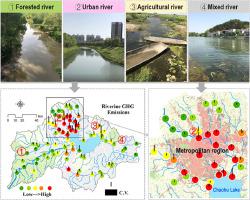Water Research ( IF 11.4 ) Pub Date : 2020-11-09 , DOI: 10.1016/j.watres.2020.116624 Wangshou Zhang , Hengpeng Li , Qitao Xiao , Xinyan Li

|
Growing evidence shows that riverine networks surrounding urban landscapes may be hotspots of riverine greenhouse gas (GHG) emissions. This study strengthens the evidence by investigating the spatial variability of diffusive GHG (N2O, CH4, CO2) emissions from river reaches that drain from different types of landscapes (i.e., urban, agricultural, mixed, and forest landscapes), in the Chaohu Lake basin of eastern China. Our results showed that almost all the rivers were oversaturated with dissolved GHGs. Urban rivers were identified as emission hotspots, with mean fluxes of 470 μmol m−2 d−1 for N2O, 7 mmol m−2 d−1 for CH4, and 900 mmol m−2 d−1 for CO2, corresponding to ~14, seven, and two times of those from the non-urban rivers in the Chaohu Lake basin, respectively. Factors related to the high N2O and CH4 emissions in urban rivers included large nutrient supply and hypoxic environments. The factors affecting CO2 were similar in all the rivers, which were temperature-dependent with suitable environments that allowed rapid decomposition of organic matter. Overall, this study highlights that better recognition of the influence that river networks have on global warming is required—particularly when it comes to urban rivers, as urban land cover and populations will continue to expand in the future. Management measures should incorporate regional hotspots to more efficiently mitigate GHG emissions.











































 京公网安备 11010802027423号
京公网安备 11010802027423号